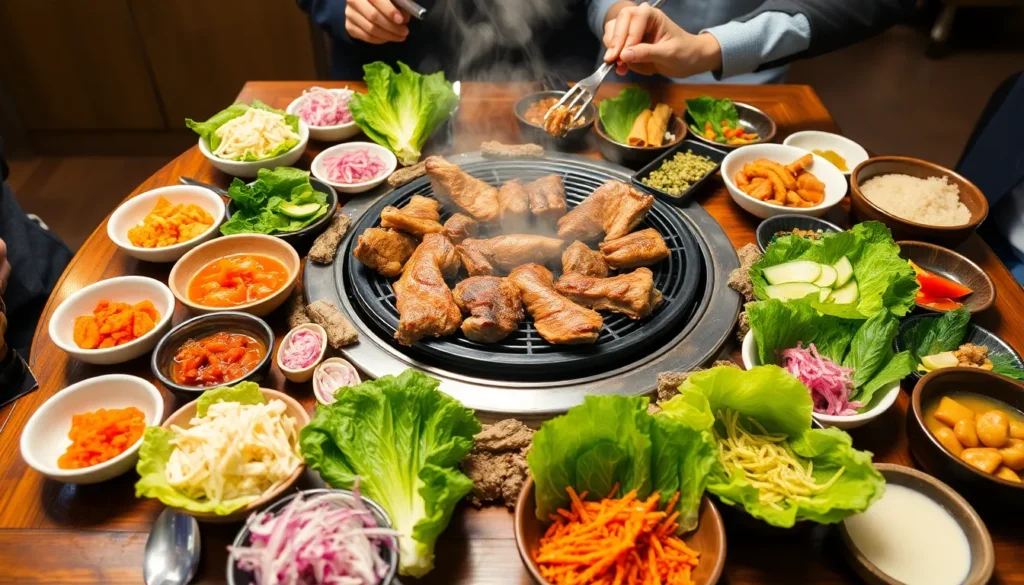Korean BBQ transforms any meal into a feast but it’s the incredible array of banchan (side dishes) that truly makes the experience unforgettable. We’ve all been there – sitting at a Korean BBQ restaurant overwhelmed by the colorful spread of small dishes that arrive before we even order our meat. These aren’t just random accompaniments; they’re carefully crafted flavor profiles designed to complement and enhance every bite of grilled perfection.
From the tangy crunch of kimchi to the refreshing coolness of cucumber salad, Korean BBQ sides create a symphony of tastes and textures that’ll elevate your home grilling game. We’re diving deep into the essential banchan that’ll transform your backyard BBQ into an authentic Korean experience.
Whether you’re planning your first Korean BBQ night or looking to expand your side dish repertoire, we’ve got the insider knowledge you need to create that restaurant-quality spread at home.
Traditional Kimchi: The Essential Fermented Side
Kimchi stands as the cornerstone of Korean BBQ banchan, delivering the perfect balance of spicy, sour, and umami flavors that cut through rich grilled meats. We’ll explore three essential kimchi varieties that transform any Korean BBQ spread into an authentic culinary experience.
Classic Napa Cabbage Kimchi
Classic napa cabbage kimchi serves as the foundation of Korean fermented vegetables, offering a complex flavor profile that develops over days of fermentation. We prepare this traditional side by salting quartered napa cabbage heads for 2-4 hours, then coating them with a paste made from Korean red pepper flakes (gochugaru), fish sauce, garlic, ginger, and scallions.
Fermentation creates the signature tangy taste that makes this kimchi irreplaceable at Korean BBQ tables. We recommend fermenting the kimchi at room temperature for 1-3 days before refrigerating, which allows beneficial bacteria to develop the characteristic sour notes. Fresh kimchi provides a crisp texture and mild heat, while aged kimchi delivers deeper, more complex flavors that pair exceptionally well with fatty cuts like bulgogi and galbi.
Storage techniques determine the kimchi’s final flavor intensity. We store properly made napa cabbage kimchi in airtight containers in the refrigerator, where it continues to ferment slowly and can last up to 6 months. The kimchi reaches peak flavor after 2-4 weeks of refrigerated fermentation, developing the perfect balance of sourness and spice that Korean BBQ enthusiasts crave.
Cucumber Kimchi (Oi Sobagi)
Cucumber kimchi offers a refreshing crunch that provides immediate relief from spicy Korean BBQ marinades and sauces. We create this quick banchan by making deep crosswise cuts in small cucumbers, stuffing them with a mixture of gochugaru, garlic, ginger, fish sauce, and chopped vegetables like carrots and scallions.
Quick preparation makes oi sobagi ideal for same day Korean BBQ meals. We salt the prepared cucumbers for 30 minutes to draw out excess moisture, then rinse and stuff them with the spice mixture. This kimchi reaches optimal flavor within 2-4 hours of preparation, making it perfect when we need fresh banchan without waiting for traditional fermentation periods.
Texture variations allow customization based on personal preferences. We slice cucumbers into rounds for a more delicate presentation, or keep them whole for traditional stuffed presentation. The cucumber’s natural water content creates a light brine that mellows the spice level, making this kimchi approachable for those new to Korean fermented foods while still providing authentic flavor complexity.
Radish Kimchi Variations
Radish kimchi varieties add distinct textures and flavors that complement different Korean BBQ preparations throughout the meal. We prepare cubed radish kimchi (kkakdugi) by cutting daikon radish into 1-inch cubes, salting them for 1 hour, then mixing with gochugaru, fish sauce, garlic, and ginger for a chunky, satisfying bite.
Julienned radish kimchi creates elegant presentation options that work particularly well alongside premium cuts like Korean BBQ short ribs. We slice daikon into thin matchsticks, creating a kimchi with delicate texture that ferments quickly due to the increased surface area. This preparation style develops tangy flavors within 24-48 hours and provides a palate cleansing effect between rich bites of grilled meat.
Seasonal radish varieties offer unique flavor profiles that enhance exact Korean BBQ experiences. We use young spring radishes for milder, sweeter kimchi that pairs well with lighter meats, while mature winter daikon creates robust, peppery kimchi that stands up to strongly marinated galbi and bulgogi. White radish kimchi also provides visual contrast on banchan tables, balancing the deep red colors of other fermented sides.
Fresh Lettuce Wraps: The Perfect Vehicle for BBQ
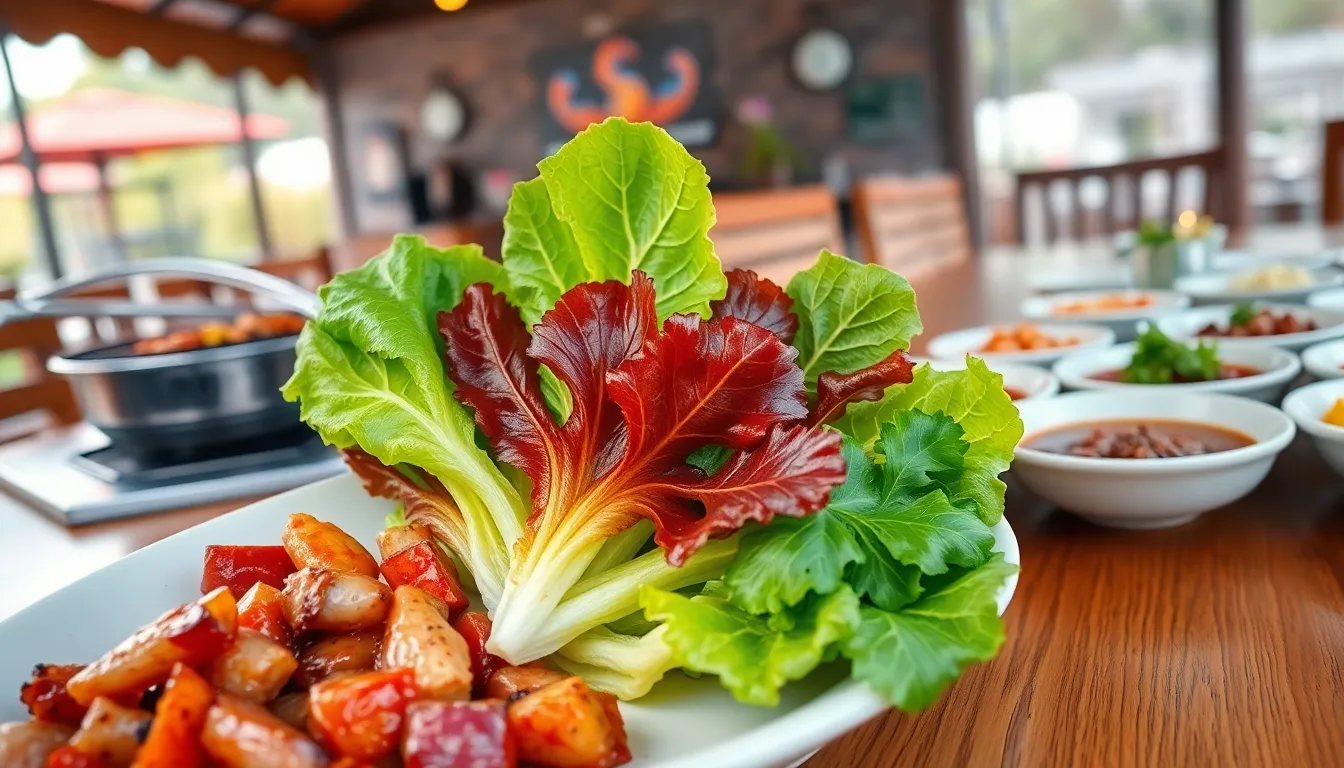
Moving beyond traditional banchan, we need to explore the essential leafy wraps that transform Korean BBQ into an interactive dining experience. These fresh vegetables serve as natural vessels for grilled meats and create the perfect balance of textures and flavors.
Butter Lettuce for Delicate Wraps
Butter lettuce offers the most tender approach to Korean BBQ wraps with its remarkably soft leaves and delicate texture. We love how these gentle leaves won’t overpower the complex flavors of marinated meats like bulgogi or galbi. The subtle sweetness of butter lettuce complements spicy gochujang marinades without adding any bitter notes that might compete with the meat’s flavor profile.
Creating the perfect butter lettuce wrap requires careful handling since the leaves tear easily. We recommend selecting the largest outer leaves and gently washing them before patting dry with paper towels. The natural cup shape of butter lettuce leaves makes them ideal for holding generous portions of meat along with rice and banchan without falling apart.
Red Leaf Lettuce for Robust Flavors
Red leaf lettuce brings a more substantial texture and slightly bitter taste that pairs exceptionally well with fatty cuts of Korean BBQ. We find that this variety’s robust structure can handle heavier meat portions like samgyeopsal (pork belly) or chadolbaegi (thin beef brisket) without wilting under the weight.
The natural bitterness of red leaf lettuce creates a refreshing contrast that cuts through rich, fatty meats and helps cleanse the palate between bites. We appreciate how the sturdy leaves maintain their crunch even when wrapped around hot grilled meat, providing a satisfying textural element that enhances the overall eating experience.
Storage becomes easier with red leaf lettuce since it maintains freshness longer than more delicate varieties. We suggest keeping the leaves crisp in cold water for 10-15 minutes before serving to ensure maximum crunch and freshness.
Perilla Leaves for Authentic Korean Experience
Perilla leaves deliver the most authentic Korean BBQ experience with their unique aromatic flavor that’s both minty and herbal. We consider these leaves essential for recreating traditional Korean dining since they’re specifically cultivated for Korean cuisine and offer flavors that Western lettuce varieties simply can’t match.
The distinctive taste of perilla leaves complements grilled meats beautifully, especially when paired with ssamjang dipping sauce. We notice that the herbal qualities enhance the umami flavors in marinated meats while the slight mintiness provides a cooling effect that balances spicy elements.
Finding fresh perilla leaves requires visiting Korean grocery stores or Asian markets, but we believe the effort is worthwhile for achieving authentic flavors. The leaves should be bright green with no dark spots, and we recommend using them within 2-3 days of purchase for optimal freshness and flavor intensity.
Savory Panchan: Small Plates That Pack Big Flavor
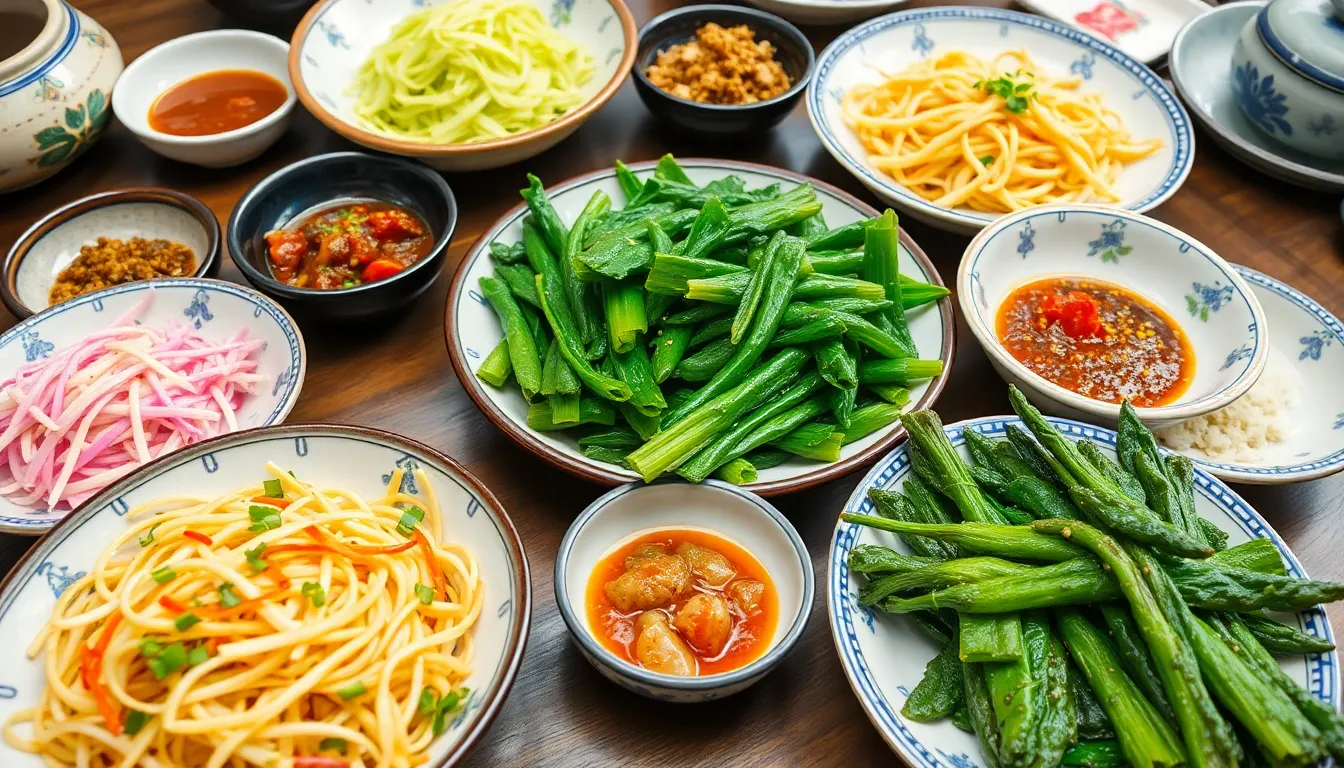
Beyond the vibrant wraps and tangy kimchi, we explore the essential vegetable banchan that complete our Korean BBQ spread. These savory small plates deliver complex flavors through simple seasonings like garlic, sesame oil, and soy sauce.
Bean Sprout Salad (Kongnamul Muchim)
Bean sprout salad brings refreshing crunch to our Korean BBQ table with its clean, nutty flavor profile. We blanch fresh soybean sprouts until tender yet crisp, then toss them with aromatic garlic, rich sesame oil, and savory soy sauce. Green onions and Korean red pepper flakes often join this mix, adding layers of flavor that complement rich grilled meats perfectly.
Preparation takes just minutes once we master the blanching technique. We drop the sprouts into boiling water for 2-3 minutes, then shock them in ice water to maintain their signature crunch. This banchan stores well in our refrigerator for up to three days, making it an ideal make-ahead side dish.
Spinach Side Dish (Sigeumchi Namul)
Spinach side dish showcases the delicate earthiness of blanched greens enhanced by traditional Korean seasonings. We lightly cook fresh spinach leaves until wilted, then dress them with fragrant sesame oil, minced garlic, and a splash of soy sauce. Toasted sesame seeds provide the finishing touch, adding nutty richness and visual appeal.
This gentle preparation method preserves the spinach’s natural minerals while creating a subtle flavor that won’t overpower our grilled meats. We squeeze excess water from the cooked spinach before seasoning to prevent dilution of flavors. The result is a silky, aromatic banchan that balances heavier BBQ dishes beautifully.
Seasoned Fernbrake (Gosari Namul)
Seasoned fernbrake offers a unique chewy texture and deep earthy taste that diversifies our banchan selection. We rehydrate dried bracken fern through careful soaking and boiling, then stir fry or toss it with soy sauce, garlic, sesame oil, and sesame seeds. This traditional preparation method transforms the tough fern into a tender, flavorful side dish.
Fernbrake requires more preparation time than other vegetable banchan, but its distinctive flavor makes the effort worthwhile. We soak the dried fern overnight, then boil it until tender before final seasoning. This banchan represents authentic Korean flavors that connect us to traditional mountain cuisine, adding cultural depth to our Korean BBQ experience.
Pickled Vegetables: Tangy Accompaniments for Rich Meats
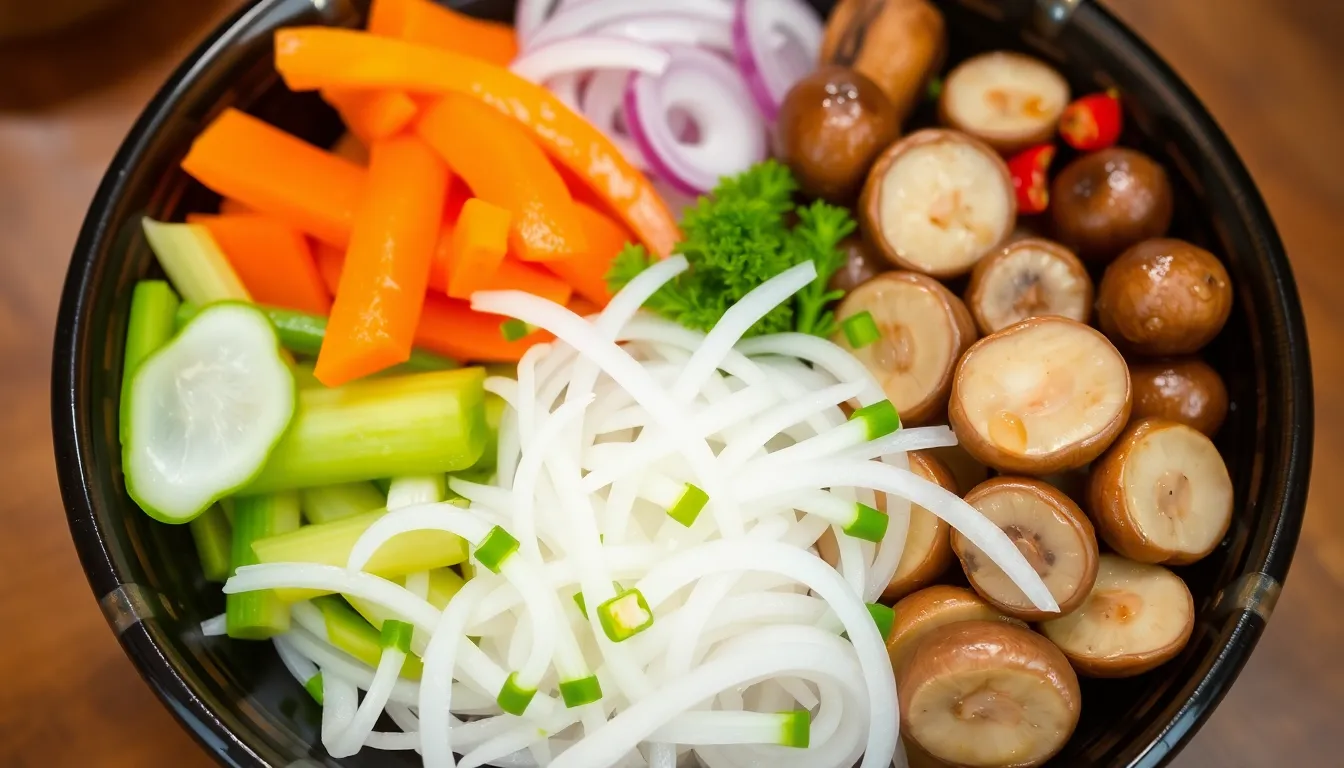
Pickled vegetables bring essential acidity and brightness to Korean BBQ that cuts through the richness of grilled meats. These tangy sides cleanse your palate between bites while adding refreshing crunch and complex flavors to every meal.
Quick Pickled Radish (Danmuji)
Quick pickled radish delivers a bright yellow color and satisfying crunch that makes it an essential Korean BBQ side dish. This tangy and slightly sweet radish helps cleanse your palate between bites of fatty grilled meat, creating the perfect flavor balance we crave during BBQ meals.
Preparation becomes simple when you slice the radish thinly and pickle it quickly in a mixture of rice vinegar, sugar, and salt. Fresh radish transforms into this refreshing side within just 30 minutes of marinating time.
Serving this banchan works best when you arrange the bright yellow slices alongside your other pickled vegetables. We recommend keeping danmuji chilled until serving to maintain its crisp texture and tangy bite.
Pickled Onions with Soy Sauce
Pickled onions with soy sauce combine sweet and salty flavors that add umami depth to your Korean BBQ spread. These marinated onions develop a mild acidity that pairs exceptionally well with grilled pork or beef, improving the meat’s natural flavors.
Creating this side dish requires thinly sliced onions marinated in a blend of soy sauce, rice vinegar, and a touch of sugar. The soy sauce adds that essential umami element while the vinegar provides the tangy contrast your palate needs.
Storage tips help maintain the onions’ perfect texture and flavor balance. We suggest keeping them refrigerated for up to one week, allowing the flavors to develop deeper complexity over time.
Marinated Mushrooms
Marinated mushrooms provide an earthy and savory element that complements Korean BBQ’s bold flavors perfectly. These mushrooms, typically marinated in soy sauce, garlic, and sesame oil, offer a rich umami taste that enhances your overall dining experience.
Preparing marinated mushrooms involves using varieties like shiitake or oyster mushrooms that absorb the marinade beautifully. The combination of soy sauce, minced garlic, and toasted sesame oil creates a complex flavor profile that pairs wonderfully with grilled meats.
Serving temperature matters for this banchan, as we typically serve marinated mushrooms cold or at room temperature as part of the traditional banchan spread. This allows their flavors to shine while providing a pleasant textural contrast to hot grilled meats.
Rice and Noodle Sides: Hearty Bases for Korean BBQ
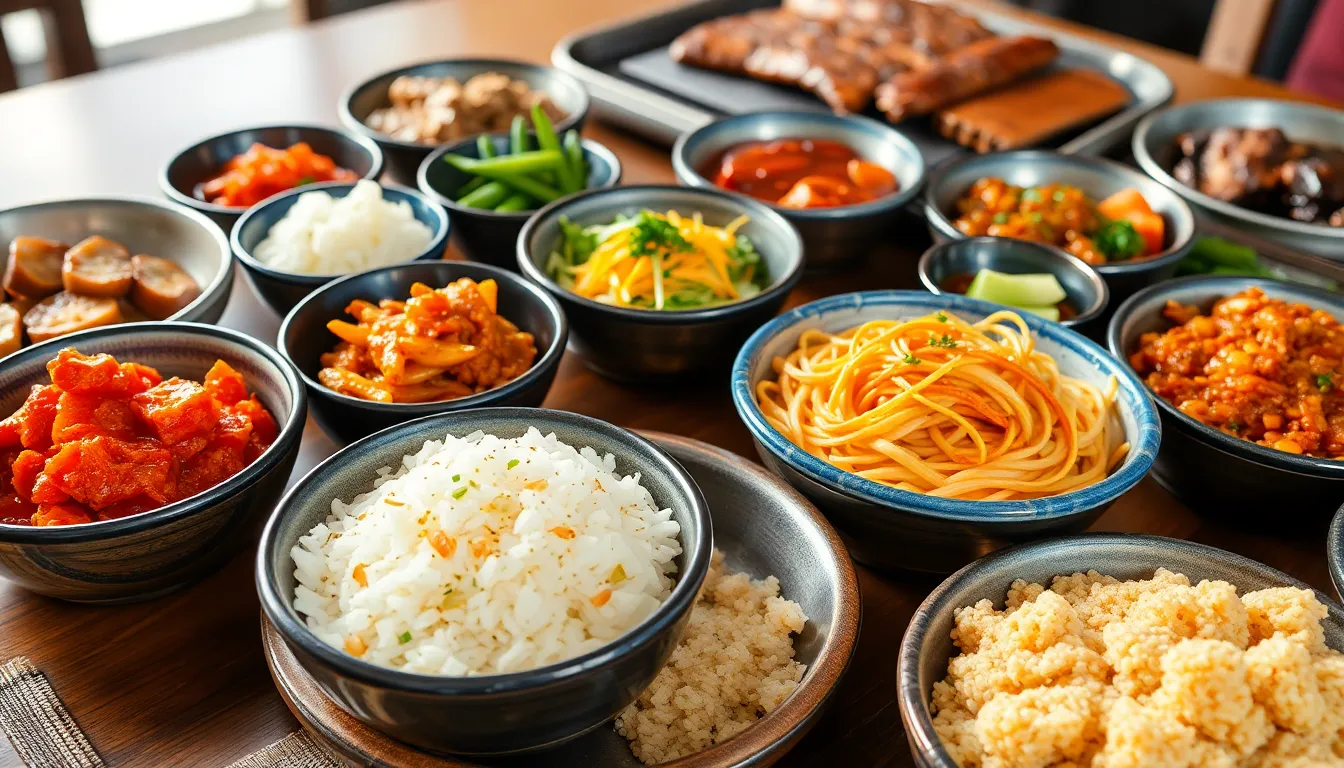
While banchan provides vibrant accompaniments, rice and noodle sides create the essential foundation for a complete Korean BBQ experience. These hearty bases balance the rich flavors of grilled meats while providing satisfying substance to every meal.
Steamed White Rice with Sesame Oil
Steamed white rice serves as the most essential foundation for Korean BBQ, transforming into something special with a simple drizzle of toasted sesame oil. We recommend using short-grain rice for its sticky texture that holds together perfectly when wrapping meat. The nutty aroma from sesame oil enhances the rice’s natural flavor without overwhelming the delicate balance of your meal.
Preparation requires cooking rice until tender, then mixing in a light coating of sesame oil while it’s still warm. This timing allows the oil to absorb properly and distribute evenly throughout each grain. We suggest using approximately one teaspoon of sesame oil per cup of cooked rice to achieve the perfect flavor balance.
Serving this rice alongside grilled meats creates a neutral base that absorbs the smoky flavors and rich marinades. The combination works particularly well with bulgogi and galbi, where the rice captures every drop of the flavorful juices.
Korean Glass Noodles (Japchae)
Japchae brings a delightful chewy texture to your Korean BBQ spread through sweet potato starch noodles stir-fried with colorful vegetables and beef. This popular side dish balances savory and sweet flavors while providing a satisfying contrast to grilled meats. The translucent noodles absorb the soy sauce and sesame oil marinade, creating bursts of flavor in every bite.
Preparation involves soaking the sweet potato noodles until soft, then stir-frying them with julienned vegetables like carrots, spinach, and mushrooms. We add thinly sliced beef for protein and season everything with soy sauce, sesame oil, and a touch of sugar for that signature sweet-savory balance. The key lies in not overcooking the noodles to maintain their distinctive chewy texture.
Flavor profile combines the nuttiness of sesame oil with the umami depth of soy sauce, creating a perfect complement to smoky grilled meats. The vegetables add freshness and crunch, while the beef provides additional protein that harmonizes with your BBQ selection.
Fried Rice with Kimchi
Kimchi bokkeumbap transforms leftover rice into a flavorful side dish that perfectly complements Korean BBQ with its tangy, spicy, and slightly fermented taste. This fried rice incorporates the bold flavors of aged kimchi, creating a hearty base that stands up to rich grilled meats. The fermentation process in kimchi adds complexity and depth that regular fried rice simply can’t match.
Cooking technique involves stir-frying day-old rice with well-fermented kimchi, allowing the kimchi’s juices to coat each grain of rice. We often add scrambled eggs and diced vegetables to create a more substantial dish. The key is using kimchi that’s been fermenting for at least a week, as this provides the ideal balance of tang and spice.
Texture combines the slight chewiness of rice with the crunch of kimchi vegetables, creating an interesting contrast to tender grilled meats. The spicy heat from the kimchi helps cut through fatty cuts of meat, while the fermented flavors add a probiotic element that aids digestion during heavy BBQ meals.
Soup-Based Sides: Warming Complements to Grilled Meats
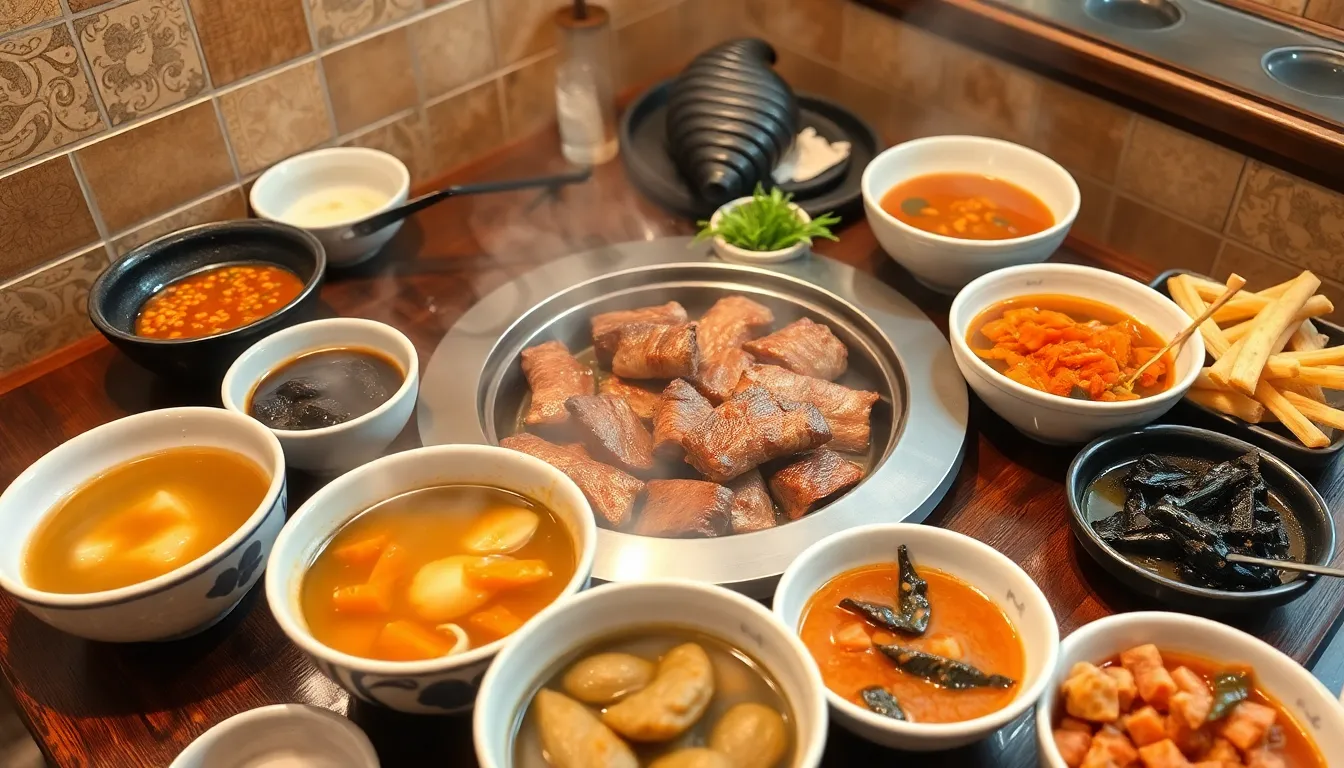
Korean BBQ soup sides provide the perfect warming balance to rich grilled meats, offering comfort and flavor contrast that enhances the entire dining experience.
Soybean Paste Soup (Doenjang Jjigae)
Doenjang Jjigae brings deep umami richness to our Korean BBQ table through its fermented soybean paste base. We combine doenjang with tofu cubes, zucchini, and onions to create this hearty soup that cleanses the palate between bites of smoky meat. The fermented soybean paste delivers complex savory notes that complement grilled beef and pork perfectly.
Traditional preparation involves simmering the soup with anchovy stock for 15-20 minutes until vegetables soften. Adding a touch of gochugaru (Korean red pepper flakes) provides gentle heat without overwhelming the soybean flavor. We recommend serving this soup hot alongside your grilled meats to help balance the richness of marinated galbi or bulgogi.
Kimchi Stew (Kimchi Jjigae)
Kimchi Jjigae offers spicy, tangy warmth that cuts through fatty BBQ cuts with its aged kimchi base. We prepare this robust stew using well-fermented kimchi, pork belly or tofu, and scallions for a satisfying contrast to smoky grilled meats. The stew’s acidity helps cleanse our palates while providing comforting heat.
Aged kimchi works best for this dish as it develops deeper flavors and softer texture during cooking. Simmering the stew for 20-25 minutes allows the kimchi’s tang to mellow while maintaining its characteristic bite. We often add a beaten egg during the final minutes of cooking for extra richness that pairs beautifully with grilled short ribs.
Seaweed Soup (Miyeok Guk)
Miyeok Guk provides a light, refreshing contrast to heavy BBQ dishes through its delicate seaweed broth. We appreciate this soup’s gentle flavor profile that doesn’t compete with grilled meats while offering essential nutrients and hydration. The tender seaweed creates a pleasant texture that complements the smokiness of Korean barbecue.
Preparation involves soaking dried miyeok seaweed for 30 minutes before cooking with beef or anchovy broth. Light seasoning with garlic, sesame oil, and salt enhances the ocean flavor without masking the seaweed’s natural taste. We serve this soup at the beginning of our meal to prepare our palates for the rich flavors ahead.
Modern Fusion Sides: Contemporary Takes on Korean Flavors
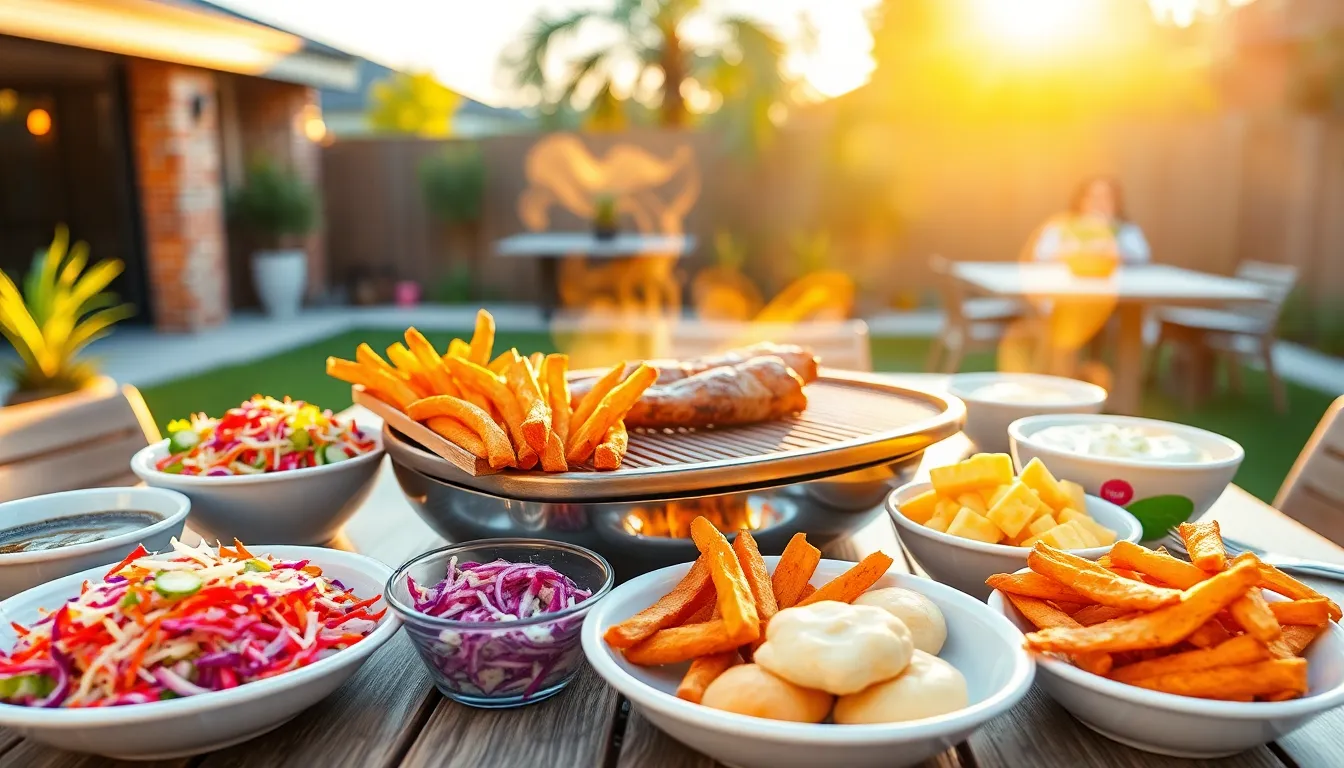
Contemporary Korean BBQ embraces creative fusion sides that blend traditional Korean ingredients with global culinary techniques. These modern accompaniments offer exciting flavor combinations while maintaining the authentic Korean elements that make each meal memorable.
Korean Coleslaw with Gochujang Dressing
Korean coleslaw transforms the classic Western side dish into a spicy, tangy sensation that perfectly complements grilled meats. We create this fusion by combining crisp cabbage and carrots with a gochujang-based dressing that balances heat, sweetness, and acidity.
The dressing combines gochujang with rice vinegar, honey, and sesame oil to achieve the ideal flavor profile. Fresh ginger and garlic enhance the complexity while sugar balances the heat from the Korean chili paste. This vibrant slaw provides a refreshing crunch that cuts through the richness of marinated bulgogi or galbi.
Preparation takes just 15 minutes, making it an excellent quick side for weeknight Korean BBQ dinners. The slaw tastes best when chilled for at least 30 minutes, allowing the flavors to meld together beautifully.
Sweet Potato Fries with Korean Spices
Sweet potato fries get an exciting Korean makeover with aromatic spices that elevate this popular side dish. We season these golden fries with gochugaru, garlic powder, and a touch of brown sugar to create a sweet, spicy, and savory combination.
The natural sweetness of sweet potatoes pairs wonderfully with the smoky heat of Korean red chili flakes. Sesame oil adds richness while a sprinkle of sea salt enhances all the flavors. These spiced fries provide a modern contrast to traditional Korean BBQ sides while maintaining authentic Korean taste elements.
Baking at 425°F for 25-30 minutes creates the perfect crispy exterior and fluffy interior. We recommend cutting the sweet potatoes into uniform wedges to ensure even cooking and optimal texture.
Corn Cheese (Korean Corn Dogs)
Corn cheese represents one of Korea’s most beloved comfort foods that’s become a staple at modern Korean BBQ restaurants. We prepare this indulgent side by combining sweet corn kernels with melted mozzarella cheese, creating a creamy, satisfying dish that contrasts beautifully with grilled meats.
The dish typically includes mayonnaise and a touch of sugar to enhance the sweetness and create the signature creamy texture. Some variations incorporate butter and garlic for additional richness. This cheesy side provides a comforting element that balances the bold flavors of spicy Korean marinades.
Preparation involves mixing the ingredients in a cast iron skillet and broiling until the cheese becomes golden and bubbly. The result is a warm, gooey side that’s perfect for sharing and adds an interactive element to your Korean BBQ experience.
Conclusion
With these diverse banchan options in your repertoire you’re ready to create memorable Korean BBQ experiences at home. We’ve covered everything from traditional fermented kimchi to modern fusion sides that’ll impress your guests and satisfy your cravings.
The beauty of Korean BBQ lies in the harmony between grilled meats and these carefully crafted side dishes. Each banchan brings its own personality to the table whether it’s the tangy crunch of pickled vegetables or the comforting warmth of traditional soups.
Start with a few simple sides like steamed rice and quick cucumber kimchi then gradually expand your collection. Your Korean BBQ spread will become more authentic and exciting with each new banchan you master.
Frequently Asked Questions
What are banchan and why are they important for Korean BBQ?
Banchan are the array of side dishes served with Korean BBQ that enhance the overall dining experience. They provide variety in flavors and textures, from spicy and tangy to refreshing and crunchy, that complement grilled meats perfectly. These traditional side dishes are essential for creating an authentic Korean BBQ experience at home.
What are the three essential kimchi varieties for Korean BBQ?
The three essential kimchi varieties are classic napa cabbage kimchi, cucumber kimchi (oi sobagi), and radish kimchi variations. Classic napa cabbage kimchi offers complex fermented flavors, cucumber kimchi provides refreshing crunch for quick preparation, and radish kimchi varieties deliver distinct textures and flavors that pair well with different meats.
Which leafy vegetables work best as wraps for Korean BBQ?
The best leafy wraps include butter lettuce, red leaf lettuce, and perilla leaves. Butter lettuce offers tender wrapping without overpowering marinated meats, red leaf lettuce provides robust texture with slight bitterness for fatty cuts, and perilla leaves deliver authentic Korean flavor that enhances umami and balances spicy elements.
What are the most popular vegetable banchan dishes?
Popular vegetable banchan include bean sprout salad (Kongnamul Muchim) with its refreshing crunch and nutty flavor, spinach side dish (Sigeumchi Namul) featuring delicate earthiness, and seasoned fernbrake (Gosari Namul) offering unique chewy texture and deep earthy taste that represents authentic Korean flavors.
How do pickled vegetables enhance Korean BBQ?
Pickled vegetables add tangy accompaniments that cut through the richness of grilled meats. Quick pickled radish provides bright color and satisfying crunch, pickled onions with soy sauce combine sweet and salty flavors with umami depth, and marinated mushrooms offer earthy, savory elements that enhance the overall dining experience.
What rice and noodle sides complement Korean BBQ?
Essential rice and noodle sides include steamed white rice with sesame oil as a neutral base for absorbing flavors, Korean glass noodles (Japchae) providing chewy texture with balanced sweet-savory flavors, and kimchi fried rice (kimchi bokkeumbap) transforming leftovers into a flavorful dish that complements rich grilled meats.
Which soup-based sides work well with Korean BBQ?
Popular soup-based sides include soybean paste soup (Doenjang Jjigae) with its hearty, palate-cleansing properties, kimchi stew (Kimchi Jjigae) offering spicy, tangy warmth that cuts through fatty BBQ cuts, and seaweed soup (Miyeok Guk) providing a light, refreshing contrast with its delicate broth.
What are some modern fusion banchan options?
Modern fusion sides include Korean coleslaw with gochujang dressing that transforms the classic Western dish into a spicy, tangy complement, sweet potato fries seasoned with Korean spices for a contemporary twist, and corn cheese, a beloved comfort food that adds creamy, indulgent elements to the meal.

